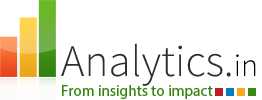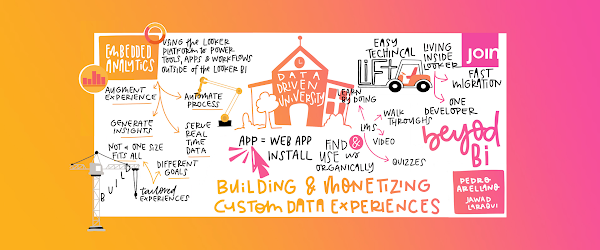JOIN@Home was an incredible celebration of the achievements that the Looker community made in the last year, and I was proud to be a part of it. Prominent leaders in the data world shared their successes, tips, and plans for the future. In the spirit of keeping the learning alive, I summarized the top two takeaways from each of the keynotes. They’re accompanied by illustrations that were captured live during the sessions by a local artist.
Plus, there’s a fun surprise for you at the end.
“Celebrating Data Heroes – Transforming Our World with Data”
Our opening keynote featured a number of inspiring data professionals who use Looker in their work every day to see trends, drive decision making, and grow their customer base.
Some of their main takeaways were:
You can use analytics to make change for the greater good.
Surgeon scientist Dr. Cherisse Berry spoke of cross-referencing healthcare outcomes data like trauma care survival rates, how long patients wait before being seen, and whether patients were appropriately triaged with demographic data to find gender and racial disparities in healthcare. For instance, she found that critically injured women receive trauma care less often than men. Because her analysis made the disparity known, informed decisions and actions can be taken to bring greater equality to New York state’s trauma care system.
Provide templates to make insights more easily available to more users, especially non-technical ones.
Michelle Yurovsky of UIPath, an automation platform that helps customers avoid repetitive tasks, shared one of the key ways UIPath gets customers engaged: by providing dashboard templates that answer common automation questions. Customers get useful insights the second they click on the product. They can copy and modify the templates according to their business needs, so they’re less intimidated to start working with analytics – especially if they have no previous experience building dashboards.
*Source: Coursera internal data, November 2021.
“Developing a Better Future with Data”
This keynote looked to the future of analytics.
Two major themes were:
Composable analytics capabilities help make application development faster, easier and more accessible.
Composable analytics means creating a custom analytics solution using readily available components. You have access to composable analytics with Looker through the extension framework, which offers downloadable components you can use to build your application right on top of the Looker platform. Filter and visualization components enable you to more easily create the visual side of these data experiences.
Augmented analytics help make it easier to handle the scale and complexity of data in modern business – and to make smarter decisions about probable future outcomes.
Augmented analytics generate sophisticated analyses, created by integrating machine learning (ML) and artificial intelligence (AI) with data. The Looker team has worked to make augmented analytics more accessible to everyone this year. In particular, new Blocks give you access to ML insights through the familiar Looker interface, enabling you to more quickly prototype ML- and AI-driven solutions. For instance, the Time-series Forecasting Block (which uses BigQuery ML) can be installed to give analysts deeper insights into future demand for better inventory and supply chain management. CCAI Insights gives call centers access to Contact Center AI Insights data with analysis they can use immediately.
“The Looker Difference”
Product Managers Ani Jain and Tej Toor highlighted many recent features you might find useful for activating and enabling users with Looker.
Here are two moments that stood out:
Giving your teams better starting points can lead to more engagement with analytics.
Two improved ways to find insights from this year: Quick Starts and board improvements. Quick Starts function as pre-built Explore pages that your users can open with a click, helping to make ad hoc analysis more accessible and less intimidating. They’re also a convenient way to save an analysis you find yourself doing frequently – and they even save your filter settings. And, with new navigation improvements in Looker, boards are easier to find and use. Now you can pin links to a board, whether it’s a dashboard, a Look, an Explore, or something else, including external links. So go ahead. Try your hand at creating a useful data hub for your team with a new board.
Natural language processing and Looker can help you make sense of relationships within data, quickly.
A great example of this is the Healthcare NLP API Block, which creates an interactive user interface where healthcare providers, payers, pharma companies, and others in the healthcare industry can more easily access intelligent insights. Under the hood, this Block works on top of GCP Healthcare NLP API, an API offering pre-trained natural language models to extract medical concepts and relationships from medical text. The NLP API helps to structure the data, and the Looker Block can make the insights within that data more accessible.
“Building and Monetizing Custom Data Experiences with Looker”
Pedro Arellano, Product Director at Looker, and Jawad Laraqui, CEO of Boston-based consultancy Data Driven, chatted about embedded analytics and the remarkable speed one can build data applications with Looker and monetization strategies.
Points you don’t want to miss from this one:
Looker can help you augment an existing customer experience and create a new revenue stream with embedded data.
For example, you can provide personalized insights to a customer engaged with your product, or automate business processes such as using data to trigger a service order workflow when an issue is encountered with a particular product. Embedding data in these ways can make the customer experience smoother all around. To take it a step further, you can monetize a data product you build to help create a new revenue stream.
Building for Looker Marketplace can help you find more customers for your app and can promote a better user experience.
Jawad compared using the extension framework to build for the Looker Marketplace as having an app in the Apple store. Being in the Marketplace is a way for customers to find and use his product organically, and it helps give the end users a streamlined experience. He said: “We were able to quickly copy and paste our whole application from a stand-alone website into something that is inside of Looker. And we did this quickly—one developer did this in one day. It’s a lot easier than you think, so I encourage everyone to give it a try. Just go build!”
“Looker for Modelers: What’s New and What’s Next”
Adam Wilson, Product Manager at Looker, covered the latest upgrades and future plans for Looker’s semantic data model. This layer sits atop multiple sources of data and standardizes common metrics and definitions, so it can be governed and fed into modern built-in business intelligence (BI) interactive dashboards, connected into familiar tools such as Google sheets, and other BI tools where users work —we’re calling this the unified semantic model.
Capabilities to look out for:
Take advantage of Persistent Derived Table (PDT) upgrades that facilitate the end-user experience.
You can use incremental PDTs to capture data updates without rebuilding the whole table, meaning your users get fresh data on a more regular basis with a lower load on your data warehouse. And it’s now possible to validate PDT build status in development mode, giving you the visibility needed to determine when to push updates to production. Coming soon, you’ll be able to do an impact analysis on proposed changes with visualized dependencies between PDTs.
Reach users where they are with Connected Sheets and other BI tools.
Coming soon, you’ll be able to explore Looker data in Google Sheets and share charts to Slides, too. And with Governed BI Connectors, Looker can act as a source of truth for users who are accustomed to interacting with data in Tableau, Power BI, and Google Data Studio. You can sign up to hear when the Connected Sheets and Looker integration is available or separately to hear about preview availability for Governed BI Connectors.
* Source: The Total Economic Impact™ of Looker, Forrester Consulting, June 2021.
A commissioned study conducted by Forrester Consulting on behalf of Google Cloud
** Source: Google Community Data, December 2020, 2021
Hackathon
Speaking of interesting new developments, here’s your fun surprise: a hackathon recap with a new chart you can use in your own analytics.
The Looker developer community came together to create innovative Looker projects at this year’s JOIN hackathon, Hack@Home 2021. The event provided the participants access to the latest Looker features and resources to create tools useful for all Looker developers. The Nearly Best Hack Winner project demonstrated how easy it is to make custom visualizations by creating an animated bar chart race visualization that anyone can use. The Best Hack Winner showcased the power of the Looker extension framework with a Looker application that conveniently writes CSV data into Looker database connections.
You can still view all the keynotes, as well as the breakout sessions and learning deep dives, on-demand on the JOIN@Home content hub. These will be available through the end of the month, so go soak up the learning while you can.
Source : Data Analytics Read More

